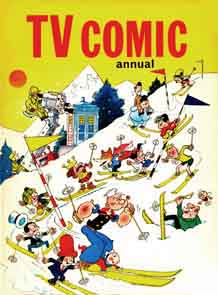The 1970 TV Comic Annual

|
|
Polystyle Publications Ltd The 1970 TV Comic Annual |

|
| Published | 1969 |  |
| Starring the second Doctor |
A Review by Finn Clark 23/7/04
It's the last year for Beetle Bailey! Darn it. Beetle rocks. Otherwise the usual suspects are present and correct... Arthur, Basil Brush, Diddymen, Mad Movies, Mighty Moth, Popeye and TV Terrors are all much as usual. No huge surprises. Arthur overflows with wrongness... King Arthur, Sir Lancelot and the Knights of the Round Table, reduced to this? (Oh, and someone clearly had a bad experience with their dustman.) Basil Brush is still toffee-nosed, in one story helping the Gents beat the Riff-Raff at soccer. You couldn't publish a story like that these days. It's worth reading just for the political incorrectness.
Meanwhile in Mighty Moth, Dad dresses up as "Superslob". Bob Monkhouse's Mad Movies also has an above-par story in which the Krooks get ripped off by a garage mechanic. Millions of motorists know how they feel!
To be honest, most of these kiddie strips feel indistinguishable. They all have the same jokes, from Laurel and Hardy to Bob Monkhouse's Mad Movies. The best ones are those with a bit more personality, such as Beetle Bailey, TV Terrors or the newly-acquired Bugs Bunny show (which at least has good supporting characters). This year's other newcomers are Tich and Quackers, taken from the act of a TV ventriloquist called Ray Alan. Curiously, Ray Alan's sidekick for Tich and Quackers was Tony Hart, who designed the Blue Peter ship and brought art to children's TV with Vision On, Take Hart, Hartbeat and more.
The Avengers get a text story... and it's the Tara King era already! I'd forgotten how old The Avengers were. Here Steed and Tara meet characters from Alice in Wonderland, Treasure Island and A Tale of Two Cities as they fight Silas Bookworm and his Three Dimensional Book machine. There's also another story for Skippy the bush kangaroo, but let's pretend that there isn't.
The Dr Who stories are okay, but they're the most sensible (and thus least entertaining) of Troughton's three TV Comic annuals. Almost inevitably they're drawn by John Canning, though sadly the 2nd Doctor is now travelling without John and Gillian. Damn shame, I call it.
Death Race stars those evil galactic conquerors, the Quarks! Hoping to hit the next big thing, TV Comic snapped up the rights to 'em in 1968 and featured them in six stories over eight months without once mentioning the Dominators. (Unfortunately this deal was done without the involvement or even knowledge of their original creators, Mervyn Haisman and Henry Lincoln. This caused a serious bust-up when those gentleman eventually found out about it.) This story is set in the year 2053 and space craft from all over the universe have gathered in the sky above London to follow the historic race... an annual veteran car rally. Good to know that galactic civilisations have their priorities right. Naturally the Quarks are present. ("There! In that vehicle, our arch-enemy, Dr Who!") It's not a particularly memorable story, but it's silly fun in which the Doctor defeats Quarks and wins the race!
The other story, Test Flight, was reprinted in David Banks's Cybermen book. It's a straightforward tale of the Doctor, more Tenth Planet Cybermen and the test flight of an experimental rocket plane. Curiously the first page has the Doctor greeting an old friend, Commander Knight. A Web of Fear reference, perhaps? (It wouldn't be an accurate Web of Fear reference since Knight didn't survive his debut story, but such details rarely stopped TV Comic.)
Things I learned from reading this book: